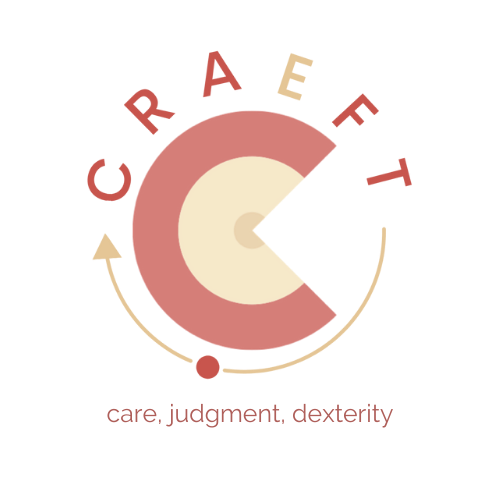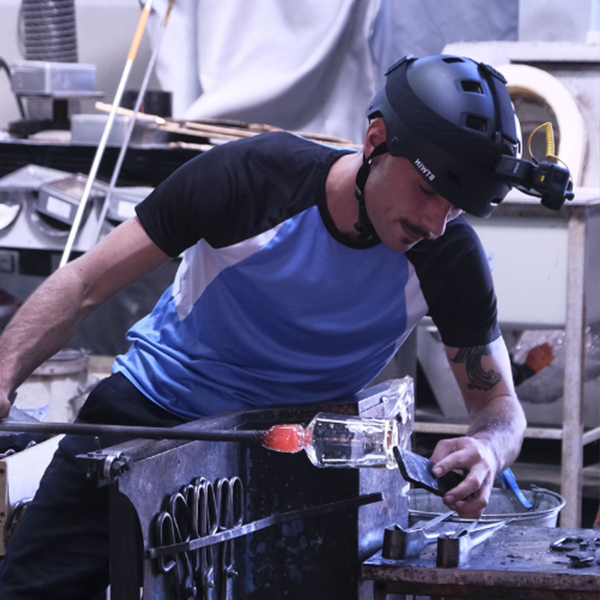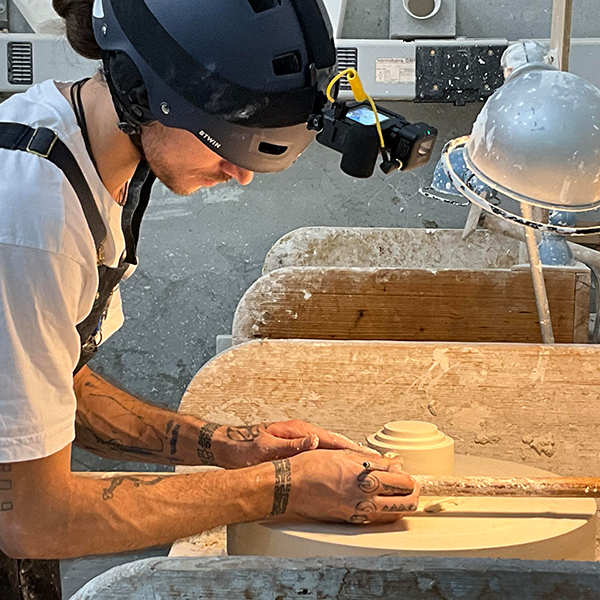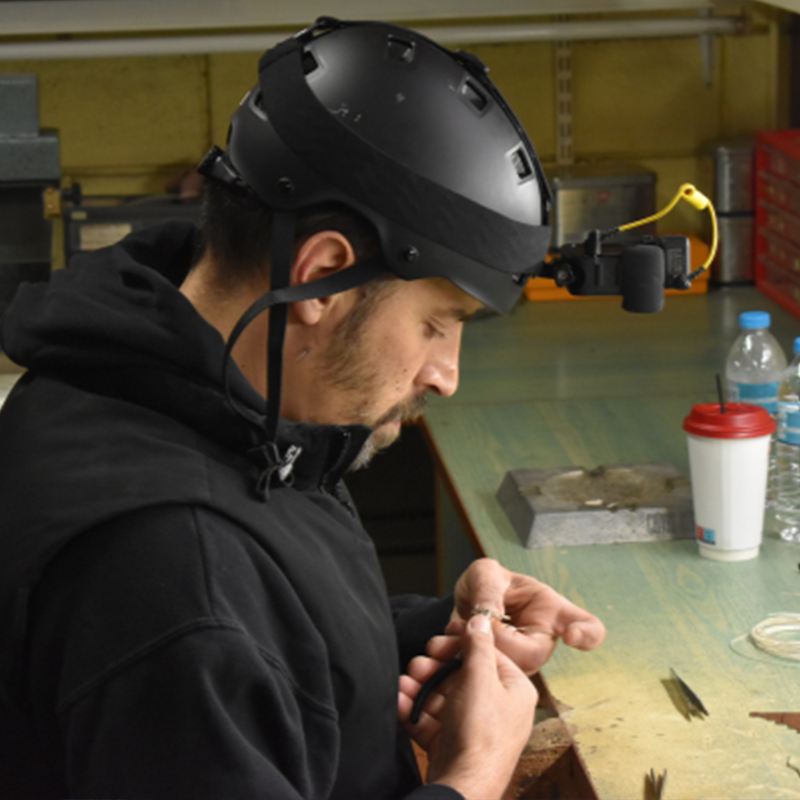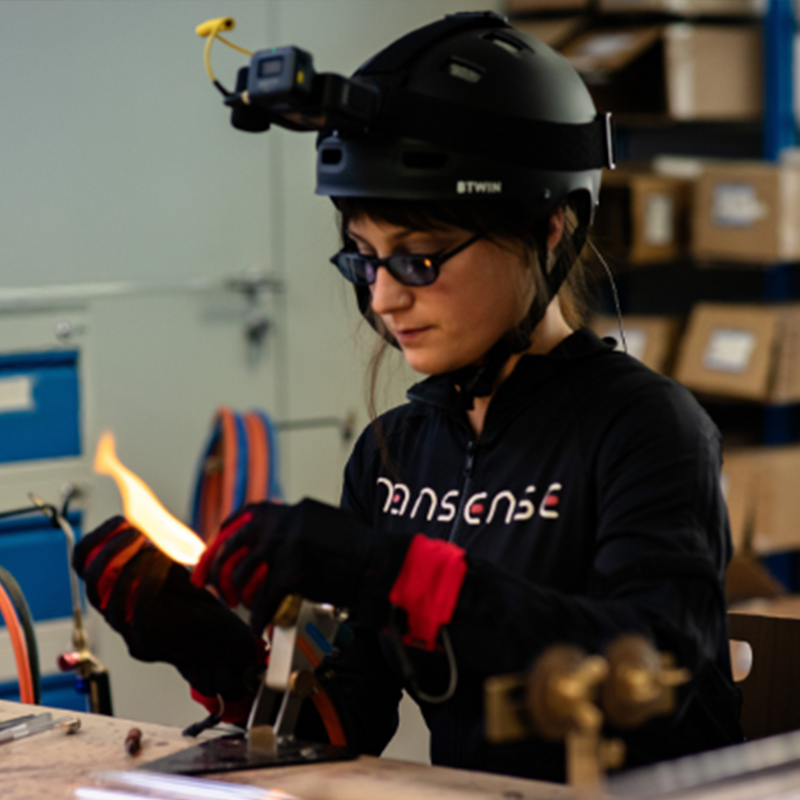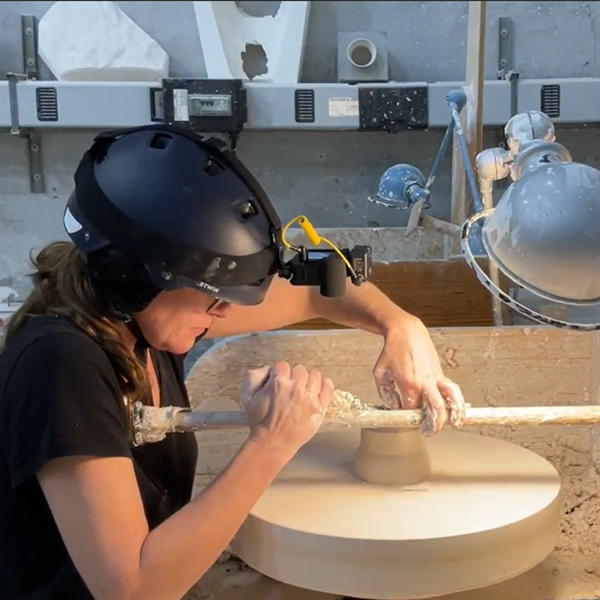Objectives
The scientific core of this application is the generality of understanding the making process, as the purposeful interaction of the mind with the world through senses and actions. Formal representation of knowledge is essential for reenactable preservation, but also computational understanding of human creative tasks, enabling us to provide more specific tools for its aid. Generative, realistic reenaction (simulation) and simulated imagery allows to assess the correctness of the representation of elusive concepts such as tacit knowledge. Craft-specific simulation is a powerful tool for learning but also optimising workflow efficiency. Short-term predictive imagery of intended actions can be seen as a “precautious undo” for mistakes in work of risk.
O1 Understanding crafting actions and processes, in a Maker-Material-Negotiation model
Craft taxonomies are material oriented[1] and classify materials by origin (mineral, flora, fauna are the main classes) and special categories exist for compositions (e.g., musical instruments, brocades). To cope with the diversity of crafting techniques we adopt two classifications (see figure below), (1) Actions are classified into Add, Subtract, Interlock, or Transform operations. (2) Materials are classified by the compatibility to practitioner actions, as Free-form (plastic) materials that take any shape, Fibres interlocked into fabrics and Solids that are reduced to a subset of their original volume. A notable subclass of 3D solids are 2D surfaces (see O2). Some crafts combine techniques, as in the crafting of musical instruments.

Through a unifying model, the mechanical, perceptual, and intellectual components of crafting activities can be brought together, as the negotiation[2] between the maker and the material, with the following notions.
In crafts, actions transform materials. Action is “the unit activity attended by a practitioner”[3]. Action plans are hypotheses for the achievement of goals, under prescribed conditions on the state andthe spatial arrangement of materials. Plans require power and affordances[4], availed by working spaces, hands & body, and tools, and agents of, heat, moisture, chemical reaction or colour pigmentation. A goal is encoded in mental imagery, as the result of a mental simulation (planning). Mental imagery envisages the anticipated sensory imagery, should the goal be achieved.Actions upon materials are mediated by tools and/or hands. During the action, the practitioner attends to external (sensory) and internal (somatosensory) stimuli that inform on the course of the action. The practitioner modulates actuation parameters accordingly. The result is attended in perceptual imagery created by the senses. Due to actuation, more stimuli are generated. Some actions even have solely sensory goals, e.g. tactile inspection of surface smoothness. A technique or crafting process combines actions in “umbrella plan”[3] called a process schema. Crafting processes interchange between work of risk and certainty. Special plans are made to handle errors. After acting, the practitioner compares mental and sensory imagery and updates or reconfirms the action parameters. Upon completion of a process, the practitioner reflects on its course and outcome and may update it.
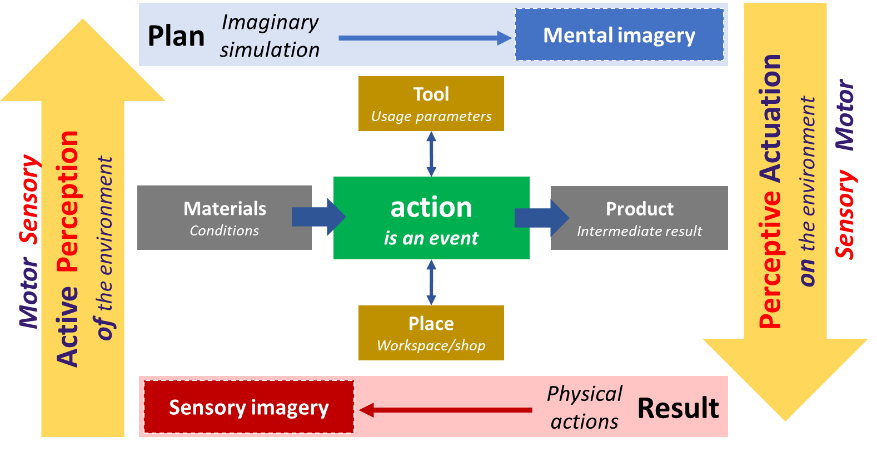
Digitisation of crafting objects and activities as signals includes surfaces, anaglyphs, solids, human & tool motion, material deformation, sounds, and sometimes heat, humidity and other properties. Their analysis yields grips, postures, and gesture representations that aim understanding and reenactment. CREAFT brings advanced background digitisation methods that will be extended for materials frequently encountered in crafts, such as transparent, translucent, shiny, but also surface textures (tactile sensation) that exhibit digitisation challenges.
Memories of internal signals (qualia) will be verbally testified, but also recognised out of simulated imagery generated by audio, visual, or haptic rendering[5]. The particular rendering is, then, a digitisation of the sensory imagery the practitioner “feels”. The use of tacit knowledge is revealed by psychophysical analytics on perceptual performance (i.e., two-alternative forced-choice) tools. In these ways, advanced ethnographic observations will be designed and applied in eight RCIs spanning the range of techniques and materials. Comparative studies ensure their accurate modelling through differences and similarities. Ethnography will include contextualisation narratives on the technological, social, historical and economic context of RCI evolution until today.
An ontology for crafts (CrO)[6] will be extended to associate semantics and signals for the new entities (hypotheses, affordances). The Craft Authoring Platform (CAP) will extend MOP to instantiate entities of the new ontology and provide additional services. Using this CAP, knowledge entities are linked to digital assets that reconstruct objects and record actions. All entities and data will be encoded in CIDOC-CRM and EDM and will be oriented to the “Event” class that is central in both. This way, assets and entities will be accessible via Semantic Web and Europeana.
O2 Digital reenactment of craft actions and processes
Understanding a cognitive process means being able to recreate or simulate it[7]. To validate the sufficiency of the model, Craeft will create a generator for craft-specific simulators, based on generative a set of adaptive archetypal action simulators. Archetypal simulators will digitally reenact the basic classes of actions, abstracting mechanics via computational modelling[8] of operation principles of (1) Add/Subtract by Constructive Solid Geometry, (2) Interlock by Knot/Textile Algebras, and (3) Free-form by mass-preserving, free-form 3Dand 2D transforms[9]. Simulators will model mechanical affordances as Archimedean Simple Machines (e.g. a knife is a wedge) or physical & chemical (conditioning) agents i.e., heat, moisture, chemical etc. Hands (and feet) enable a sea of diverse affordances and mechanics, are agents of energy, dexterous force, and are (also) tactile sensors. Naturally, hand-interaction follows the laws of physics, but the – yet unsurpassed – delicacy and granularity of control and sensation are to be studied more closely based on ETH’s seminal work[10].

The proposed generator will refine archetypal simulators to specific craft-specific simulator instances. The implementation will use Artificial Intelligence to transfer knowledge and learn to simulate actions by refining archetypes from craft element annotations that associate semantic knowledge entities with digital recordings of hand, body, tool motion, gestures, material transformation events (semiotics), knowledge of the action taking place, and 3D/4D reconstruction of all material, dynamic events and deformations. The training of this generator will be scrutinous using comparative studies, to learn how “the same” action is parameterised and manifested across tools and materials. The left inset illustrates the idea of learning the variation in affordances (shape and scale of the tool), parameters (force, movement resolution), and sensory stimuli utilised (vision, tactile inspection). Bimanual handing and interpersonal coordination will be central to account for synchronised actions.
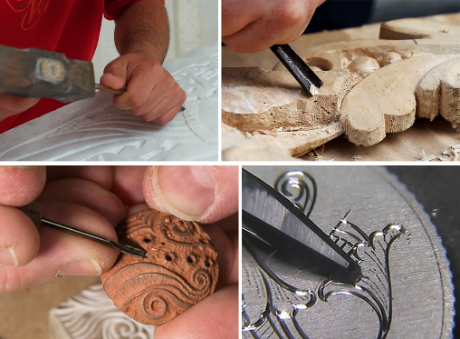
Action simulators will visualise techniques, enable modulation of action parameters, space and time, offer inventories of tools, and predict the results of the action on the material. The right inset shows two glasswork action simulators that were “digitally handcrafted”, that is developed by a combination of scanned models, MoCap, identification of grip posture and gestures, and human programming glass transformations[11]. Such action simulations will be semi-automatically generated, with the human practitioner in the loop to ensure realism. Process simulators will organise actions and bring together partial results, considering fabrication constraints (e.g. order, concurrency, decision points) and spatial constraints of the workshop. The left inset shows a manually programmed simulator for glasswork[12], which envisages the process simulators whose development will be streamlined in the Craft Studio. Craeft will streamline the development of craft-specific simulators. Time-awareness is central in many crafts due to the change of material properties over time (e.g. blacksmiths and glassblowers “think hot”[3] as material viscosity decreases as it cools). Simulators will operate in real-time but can be retarded or accelerated for training purposes.

The simulation result, a realistic virtual artefact, is regarded as (simulated) mental imagery. Simulation analytics log the material quantity used or wasted, energy and time spent, work gestures and ‘choreography’ collaborating practitioners (left).
The Craft Studio will import and combine action and process simulators and enable 3D modelling and 4D simulation in a virtual workspace. The workspace will be experienced through conventional 3D multimedia or in immersive mode, stereoscopically and haptically. Visual immersive interfaces will include AR and VR. Haptics will simulate sensations created from the interaction of tools with materials. A special view of this environment, the Apprentice Studio, will be the main interface for education and training applications and will be dedicated to problem-solving and dexterous exercises for the student: Educational simulations on action hypotheses and process schemas and Training simulations on sensorimotor, real-time tool control. Using Craft Studio, we will create reenactable instructions for traditional & novel techniques in detail and support the recovery of lost techniques by preparing experimental archaeology hypotheses and evaluating them in the workshop.
O3 Education
Craft education regards theoretical craft knowledge taught in the classroom, i.e., inventory of tools, material conditions, material preparation recipes, and techniques. Technology is continuously providing tools aiding (remote) education and learning. Craeft will blueprint the requirements and pave the way to adopt such tools in craft education, rather than adapt to the tools that will be, or are, available[13]. Using digital assets from (O1) and Craft Studio (O2), Craeft will streamline the curation of educational material per craft as:
[1. Introduce] vocabulary, principles of material treatment, crafting processes, workspace configuration, recipes, work gestures, and measurement tools (e.g., tape measure, level). The semantic counterpart of these representations will produce verbal and visual instructions illustrating and guiding reenactment.

[2. Guide] across the inventory of techniques and learn to plan workflows. Focus on “skilled monitoring”[3], the ability to evaluate changes brought by practitioner actions and decide if they “conform to images of how the work should look at any given stage of production”[3]. Theoretical problems as in the inset figure (up) which ask to answer how the inventory of tools and techniques can be use achieve the requested result. These materials will be reused for experimental archaeology and simplified for general audiences (e.g., experiential presentations for ethnographic CHIs).
[3. Develop] critical thinking and judgement on treating craft as a problem-solving process and learn principles of continuous design[14] and improvisation, as well as the handling of errors (inset shows practitioner judgment required in detaching a glass body from the blowpipe, depending on its viscosity/temperature). For this reason, we will implement the import of partial results in the Apprentice Studio (i.e., trivially reconstructed by a mobile device), to enter them and judge/predict the effect of the next action planned and assess risks.

Craeft will provide explanatory & interactive simulations enabling learning by observation, enabling modulation of action parameters and study of their effects. Craeft will develop principles for digital educational experiences that complement conventional craft education. The material will acknowledge that mistakes and uncertainty are part of skill development and positive reward systems. Immersion will be used for safety training before visiting the workshop. Commonly occurring errors and their handling will be included in education. Recipes, frequently encountered in material preparation, will also be formally represented and extend prior work on culinary recipes[15].
O4 Training
Mastery, tacit or embodied, knowledge[16] and perception are recognised as the skill to “move work as quickly as possible with a minimum of physical errors”[3]. Central to the development of dexterity, are “learned interpretations of stimuli and experienced performance of appropriate actions”[3]. The way people master skills is through repeated practice. In crafts, the practice has a cost in material and workshop usage and, often, the instructor has to be present for the guidance of posture, attention, and action parameters. VR/AR systems are systematically used for vocational training. Using Craft Studio (O2) Craeft will create craft-specific immersive vocational training systems with haptic interaction for tactile sensing and actuation.Passive and dynamic haptic rendering (see inset), will simulate inspective tactile sensing (top, left), tool usage (top, right), inertia due to the weight of objects (bottom, right), and handheld digital design tools with feedback using simple DIY hardware[17].
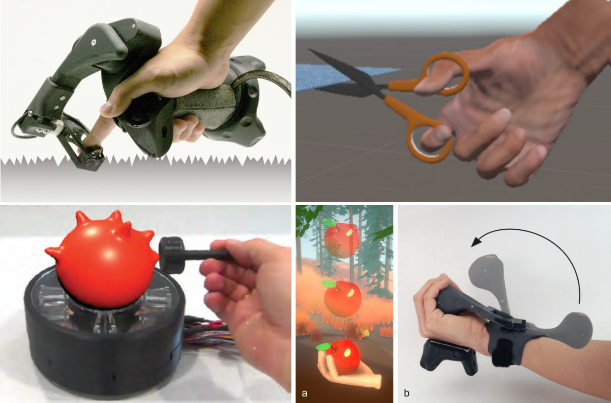
These systems will economise the development of monitoring and actuation skills, by enabling (a) practice away from the workshop (b) repeated practice on virtual materials (c) immersive telepresence of the instructor, to:
[O4-A] “Educate [train] attention”11, and learn to detect and attend to perceptual stimuli and interpret their meaning in the monitoring and control of the action at hand. These stimuli are (a) external (e.g. audio/video), signifying material qualities, properties, and events and (b) internal (e.g., proprioceptive, tactile), on awareness of hand & body posture, modulation of applied force/tension, incidence angle etc. Craeft will create training exercises in immersive simulation to train attention and interpretation of stimuli. Simulations will accustom the user to the audio environment (“soundscape”) of workshops, where noise is often present.
[O4-B] Train actuation regards the development of dexterous manipulation for tools of risk. In handwork, tactile interaction is essential to achieve realistic and beneficial training experiences for training both active perception and perceptive actuation. Craeft will combine haptic rendering and immersive environments to (1) Introduce the affordances provided by hands and tools and their degrees of freedom (2) Guide through action variability on different pieces of material. As bimanual coordination is crucial in the majority tasks, Craeft will draw ideas from background work on bimanual haptic controllers[18]. (3) Develop actuation, coordination, and synchronisation skills, through opportunities for repeated practice, particularly for free-hand operations (e.g. right inset). Stress destabilises the learning process[19] and, thus, training simulators will “slow down the time” to ease the practical challenge, similarly to music where practice initiates with a slow tempo.
[O4-C] [Social interaction in the workshop] is important for knowledge transmission. Craft materiality imposes a need for co-presence to teach the interpretation of stimuli. Communication is important because part of this knowledge is tacit and understood by the common stimuli shared by the instructor and apprentice.
Notation systems that represent human movement (mainly borrowed from dance e.g. Labanotation) were considered to represent the movement of tools but as rejected, as Wood underscores they were rejected as “not helpful for the self-directed learner to learn to read a new notation system at the same time as learning the practical skill”[20]. We agree with Wood that the alternative is the use of “representations in multimedia learning resources and cognitive design principles to afford effective learning”27. At the same time, Craeft adheres to existing “design notations” that specify the needed outcome, not motion, such as weft pattern notation[21].
05 Design
Develop new ideas, techniques, styles, and designs, first in realistic simulation (as a ‘sketch’) and then in the workshop, thus reducing experimentation cost. The workflow followed in a craft process is the practitioner’s “interpretation of the design”1, even if the designer and the maker are the same people. Risk, though, has a toll on material, energy, workspace usage, and practitioner time. Craeft will provide computer-aided digital design and fabrication to conserve these resources, in the development of new workflows and designs, as follows.
The Design Studio will use Craft Studio as an audio, visual, and haptic rendering engine to develop a 3D virtual workspace for the design, manufacturing, and presentation of artefacts. The Design Studio (T5.1) will provide:
• Haptic interfaces for design tools that capture the delicacy of human touch and increase design possibilities but also prepare for the actions to take place in the workshop. Inset shows envisioning of haptic interface[22]. • Craft-specific 3D editing tools, similar to these raster and 3D graphics editors use (inset shows “sculpting brushes” in Blender). These tools will mimic actions on virtual materials. The workflow followed to create the virtual model is then exported as verbal and visual instructions to use in the real workshop. Efficient workflows lead to material savings. • Craft-specific computer-aided design tools (T5.2) that transfer designs and styles from digital assets (T1.2) and assist design with design templates and values that apply classic design principles including, Gestalt principles of perceptual organisation, symmetry, rhythm, and figure/ground separation, for images, anaglyphs, and 3D structures. • Manufacture specialised aids for the implementation of a workflow, as in the inset figure where a handcrafted template is used in glasswork to give a particular shape to a glass body. The Design Studio will interface with subtractive/additive manufacturing devices in the appropriate formats to fabricate such aids (T5.3). This way, design-specific aids are easily fabricated and menial workflow parts automated. • Visual & haptic artefact preview in real environments in VR & AR. The utilisation of high-resolution surface scanning for accurate visual & haptic rendering. Challenges for highly reflective and transparent materials are coped by the results of T3.4. Visual simulation of the interaction of an artefact with illumination, to be implemented by the True-AR infrastructure. Haptic sensation from 2½D surface scanning T3.3. • Parts & pieces will be treated in the workflow implementation for the realistic functional preview of assets but also to study and optimise their implementation workflow. The inset shows previous work[23] of a silk liturgical vestment digitised initially as a 3D object and, then, tediously decomposed into parts that make its use meaningful (i.e. for proper dressing of a virtual human). Inversely, the Design Studio will be able to follow the workflow design and the implementation of a product from its parts. The functionality inherited by Craft Studio to enter digitised partial results will play a central role in the step-by-step and aligned with reality investigation and simulation of the “interpretation of design in a workflow”1.

O6 Preservation & Revival
[O6-1 Certification and skill acknowledgement] Educational programmes aided by the codesign and adoption of digital aids in knowledge transmission and training and certify digital design and fabrication capacities, across the range of materials and ways of formal and informal learning, as follows (see also P1 below): [RC1] Glass vocational training [RC2] Porcelain vocational training [RC3] Tapestry vocational training [RC4] Marble vocational & community training [RC5] Silversmithing community training [RC6] Woodcarving industrial training, geragogy [RC7] Clay pottery introductory experiences, pigment & sculpt decoration, experimental archaeology workshops [RC8] Traditional textile weaving and knitting informal learning in duals, dyeing recipes. Craeft will borrow ideas from the Compagnonnage[24] & Journeyship traditionalmentoring networks, of encouraging the periodically changing of work locations and craft techniques at a young age to gain experience in all arts as well residencies, apprenticeships, workshop participation. To acknowledge this experience Craeft will use the POAP[25] a standard by which projects can award personal (“soulbound”) badges that represent participation in events, with a role (e.g. student, instructor) and also provide the means to create personal portfolios of works and technique contributions.
[O6-2 Income stream diversification] Tutoring supports“earning a living from craft […] through teaching”4. Craeft will appropriate simple and immersive telepresence to enable essential interpersonal communication in online tutoring, feedback, and technical assistance on student work, to widen access to craft instructors and engage remote students. Advanced tutoring services regard specific techniques for experienced crafters, to reach new markets. Informal learning in workshops and masterclasses will be streamlined by authoring tools for educational material and skill development media(T4.1), compatible with hybrid (online/onsite) participation. Live streaming tools for the transmission of practical knowledge, underscoring preference for multimodal and multichannel communication, to simultaneously show multiple views, narrate, visually annotate, and browse accompanying material[26]. Heutagogy (self-determined learning). Over the last decade, individuals avidly use “how-to” instructions and designs from dedicated SoMe, video repositories, and illustrated instruction repositories (e.g. wikiHow) for creative recreation and to improve skills. Contributors enjoy reputation, valorised in tutoring and reputation. Experience & insight in designs valorised in • craft-themed games & toys that retain the essential and captivating elements of craft • “have-it-a-go courses where people can come along and try things out”4 as onsite experiences • content moderation for groups and heutagogy. Marketing of digital assets & designs. Realistic textures are marketed for digital design and online product presentation by several companies. Using Craeft’s 2D and 2½D scanning capacities (WP5) practitioners will be able to create textures of individual and local materials for these purposes that surpass SotA and competition in resolution (see Ambition 1.1.2). The case is similar for digital designs which are marketed for the fabrication of real artefacts, but also digital possessions in games and metaverses.
[O6-3 Community service] Lack of certification pose demotivation and quality recognition threats. Legislation for the composition, origin and naming of materials exists (see 2.1.4), but the lack of attribution to communal or individual IPR[27] poses problems when used even by non-community members for profit[28]. The problem is challenging as artists recognise their influences and convey that “there is no parthenogenesis in art”[29]. Science shares the same principles of attribution by citing past contributions, as the support of “the shoulders of giants” that enabled new works. Craeft will borrow the community values of peer review and honour the common care for the topic of interest. Acknowledgements of contributions, journeyship and compagnonnage (O6-1) will be registered in a Community Portal that links contributions and participation in events, across diverse communication channels already used in art and science to register work and receive acknowledgements. The portal protect IPR protection provide links to official trademark registrations, collective marks, and certifications.
The planned services of the portal services are Craft education & training multimodal technique demonstrations, instructions, technical assistance, remote tutoring, exercises, design inventories, activities for young members with appropriated, simplified, and ‘safetified’ introductory content, serious digital games, and safe, printable toys and DIY illustrated instructions. Valorisation, Branding, Reputation. Individual product registration (artefacts & digital assets), personal portfolios, personal pages that register certificates & credentials, practitioner interviews & masterclasses, reputation building, liaison with income streams, integration with SoMe channels and online markets for crafts (e.g., etsy.com). Online preview. Realistic 3D and environment-embedded (AR/VR) previews of products, in their environment. New technologies, new products. Serious games (digital), toys (physical) for young age and life-long learning, an association of digital dimensions to individual artefacts. Sustainable Innovation. Liaison with funding agencies, designers, and practitioners to create new enterprises, and respond to tenders, events, contests, and fairs. Offer education material for digital capacities, online presence, and promotion. Educate on legislation and licensing of designs and techniques, compliance with sustainable growth policies & certificates.
Awareness and promotion of European Crafts and Identity to counter the “falling demand or decreasing markets for craft product are partially due to a lack of awareness from potential customers that the craft exists”4.The Community Portal will provide a preliminary inventory regarding all eight RCIs and all UNESCO-inscribed European crafts[30], moderated content collections, digital exhibitions, technology, identity, and values, History of Art and Art movements, identification of communities that developed techniques and designs and traditions, memories, and values, and highlight common European culture due to crafts. Regional authorities will be welcome to add their local content to promote local identity, materials, products, and tourism services.
O7 Product valorisation
[O7-1 Digital dimensions] Craeft will provide the technology to link individual craft products with unique identifiers to bind them with digital content, certificates, and applications available online, using their appearance or by embedding visual codes in their design (T6.4) and maturing preliminary work[31] (right inset, DEMO). These online items will be either authored and stored in the CAP (T2.5) or linked through its registry to third parties. Registration of individual artefacts with secure, unique identifiers will take place in CAP.
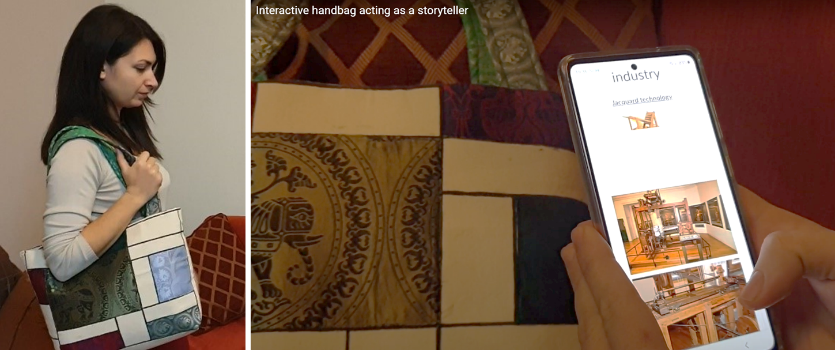
Certificates of validation and authentication purchase, creator signage, collective/certification marks, composition, origin, production method, linkage to “green” certificates of production in general (e.g. ISO 14001) and material provenance in particular (e.g. PEFC & FSC, for wood), composition & manufacturing technique, usage & repair instructions. Digital dimensions can better inform a customer on fine differences between ‘assembled’ and ‘manufactured’, ‘made’ and ‘finished’ that are linked to product quality and material composition. Product information will be complemented by repair instructions found online. Linked content can be of any type the producer of craftwork may wish to attach to an individual item or a collection of items. These can be marketing products, such as online services (incl. games), offers, combinations with other products etc. Of high interest is that craftwork customers “like the idea of having something unique to pass down through generations to come. In a time when we are constantly bombarded with things we can buy, having something that’s not off-the-shelf is becoming more important”[32]. Craeft will“increase the uniqueness”of artefacts through accompanying multimodal narratives that serve contextualisation and personalisation of objects. Contextualisation stories to be retrieved by CAP regarding ICH craft dimensions, Art History, History, technological history of the craft, local tradition & cultural tourism, local products & materials and usually attached by the producer. Personalised content can be personalised gift annotations, wises, or a digital photo album reviving memories at the time of purchase, (i.e. a visit to a village, holidays, etc). The owner will be also able to attach content over time, as a biographical object[33]. Linked narratives will be available in podcasts, electronic print, multimedia storytelling, interactive & immersive experiences.
[O7-2 New products] proposed as serious & creative digital games and physical toys for all ages.Craft-specific simulators will be reused to create serious or simplified digital games for electronic creations and design. Digital creations will be encoded in formats importable in common virtual worlds and metaverses used by both youngsters and adults. Toys will be designed and developed in Design Studio either simplified for younger audiences or designed to engage creative activities for elders (see RCI6, on geragogy). The digital blueprints of these toys can be marketed in printable formats as an electronic product (O7-1). These new products open opportunities for new jobs and professions in toy and game development, as well as electronic marketing of digital assets and designs.
[1] UNESCO (1986), Conference on qualitative and quantitative data concerning crafts, Niamey.
[2] Aktaş & Mäkelä (2019). Negotiation between the maker and material. Int. J. of Design.
[3] Keller & Keller (1996), Cognition and Tool Use, Cambridge University Press.
[4] Gibson (1966), The senses considered as perceptual systems, Houghton Mifflin.
[5] The notion is similar to facial composition software, where by tuning parameters the memory of a face can be synthesized.
[6] [CNR, FORTH] (2020), Crafts Ontology (1.0). Mingei H2020 IA, Zenodo.
[7] Marr (1982) Vision: A Computational Investigation of Human Representation & Processing of Visual Information, Freeman.
[8] Indicatively: Vilfayeau et al (2013) Numerical Modelling of the Weaving Process for Textile Composite. Key Eng. Materials Behera (2012) Modelling the structure of woven fabrics, Woven Textiles. Wang et al (2021), A constructive solid geometry-based generative design method for additive manufacturing, Additive Manufacturing. Nesme et al (2009), Preserving topology and elasticity for embedded deformable models. ACM SIGGRAPH. Field (2018), Simple Machines, Engineering Technology.
[9] 2D “free” transforms refer to a subset of mass preserving transforms, such as when folding paper or bending plywood.
[10] [ETH] (2011), Understanding Touch, ACM CHI 2011.
[11] [FORTH] (2022) Transferring Traditional Crafts from the Physical to the Virtual World, ACM J. on Comp. & Cultural Heritage.
[12] [CNAM, FORTH] (2022) Mixed-Reality Demonstration and Training of Glassblowing, Heritage.
[13] Stiegler (2012), The Formation of New Reason: Seven Proposals for the Renewal of Education, Univ. of Minnesota Press.
[14] Loh et al (2016), Workmanship of Risk: Continuous Designing in Digital Fabrication, CAD Research.
[15] [FORTH] (2021), Representation and Presentation of Culinary Tradition as Cultural Heritage, (2021).
[16] Polanyi (1958), Personal Knowledge: Towards a Post-Critical Philosophy. University of Chicago Press.
[17] [ETH] (2019) CapstanCrunch: A Haptic VR Controller with User-supplied Force Feedback ACM UIST • (2018) CLAW: A Multifunctional Handheld Haptic Controller for Grasping, Touching, and Triggering in VR ACM CHI • (2020) Omni: Volumetric Sensing and Actuation for Dynamic Haptic Feedback ACM UIST • (2020) Haptic PIVOT: On-Demand Handhelds in VR ACM UIST.
[18] [ETH] (2018) Haptic Links: Bimanual Haptics for Virtual Reality Using Variable Stiffness Actuation ACM CHI.
[19] Dehaene, Changeux (2000), Reward-dependent learning in NNs for planning and decision making. Prog. in Brain Research.
[20] Wood (2017), Transmitting craft knowledge: designing interactive media to support tacit skills learning, PhD Thesis.
[21] Albers (1965), On Weaving, Princeton University Press.
[22] [ETH] NormalTouch and TextureTouch: High-fidelity 3D Haptic Shape Rendering on Handheld Virtual Reality Controllers.
[23] [FORTH, CNR] (2022), Multimodal Narratives for the Presentation of Silk Heritage in the Museum, Heritage. DEMO
[24] Compagnonnage, network for on-the-job transmission of knowledge and identities; UNESCO inscription 5.COM 6.12.
[25] The “Proof of Attendance Protocol” creates digital badges through the use of blockchain technology. https://poap.xyz/
[26] O’Brien (2019), Crafters on Twitch: Using Livestreaming to Build Community, Craft Industry Alliance.
[27] World Intellectual Property Organization (2016), Intellectual Property and Traditional Handicrafts.
[28] Burri (2020), Cultural Heritage and Intellectual Property, Oxford Handbook of International Cultural Heritage Law.
[29] Seferis (1929), Correspondence with T. S. Eliot, compiled by Kauffer.
[30] European crafts on UNSECO 15.com 8.b.8 15.com 8.b.25 15.com 8.b.34 15.com 8.c.3 14.com 10.b.33 13.com 10.b.32 12.com11.b.10 12.com11.b.6 12.com11.b.26 10.com 10.b.17 9.com10.7 7.com11.28 7.com 11.18 5.com6.13 4.com 13.39
[31] [FORTH, CNR] (2021) An approach to enhancing handmade products with historic narratives, Int. J. of Intangible Heritage.
[32] Lily Marsh (2020), (interview, stonemason), The Importance of Preserving Heritage Crafts, Prince’s Foundation.
[33] Hoskins (1998), Biographical Objects: How Things Tell the Stories of Peoples’ Lives, Routledge.
